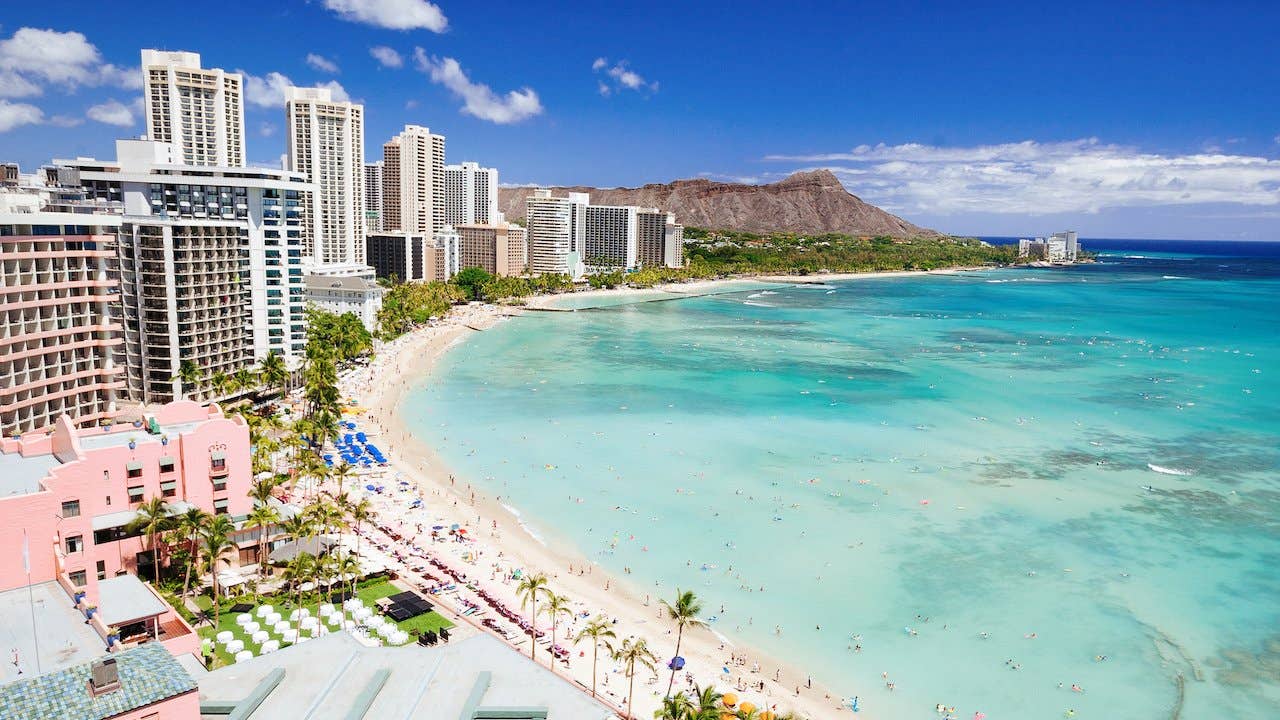2023 cost of living in Hawaii

Renowned worldwide for its natural beauty, temperate climate and unique culture, Hawaii is a top vacation destination. It can also be an alluring place to live. The islands boast low crime rates and an abundance of recreational activities.
Deciding which island to call home however, can be a daunting question. The state’s major inhabited islands vary in character, affordability, opportunity, population size and pace of life:
- Oahu: The most populated of the islands by far, Oahu is the location of Hawaii’s capital city, Honolulu. Honolulu County, which encompasses the entire island, is home to 1,016,508 people, according to the 2020 Census.
- Hawaii: Hawaii is not just the name of the state but also the name of the largest island in the archipelago, often referred to as “the Big Island.” Known for its diversity, the island of Hawaii boasts the world’s tallest mountain, 266 miles of coastline and five national parks. It’s the second most populated island with just over 200,000 residents.
- Maui: The second largest Hawaiian island geographically, Maui is famous for its stunning beaches, as well as for producing sugar and pineapples.
- Kauai: Lush scenery, picturesque waterfalls and striking canyons are the highlights on Kauai. It’s the fourth largest Hawaiian island.
- Molokai: The island of Molokai is known for being protective of its unique culture and identity. A significant percentage of the population is Native Hawaiian, and island residents actively work to preserve a rural lifestyle.
- Lanai: For years, most of the island of Lanai was a pineapple plantation. However, tourism is now emerging on the island.
As a remote island archipelago where many consumer goods must be shipped from other places, the steep cost of living in Hawaii is well-known. And like much of the rest of the country, inflation has been driving the cost of living on the islands even higher.
Hawaii statistics
Hawaii is the most expensive state in the country to live in, according to World Population Review rankings. As of December 2021, the median price of a home in Hawaii was $1.06 million, according to real estate firm Locations Hawaii. However, it also has the fourth lowest poverty rate. Here are some of the state’s key characteristics.
- Median household income: $83,173
- Per capita income: $37,013
- Average salary: $78,148
- Unemployment rate: 4.2%
- Poverty rate: 8.9%
- Median age: 39.4 years old
Hawaii’s population has been decreasing for five years running. The most recent Census data shows the population as of July 2021 at about 1.4 million people, which was a decline of .7 percent from one year earlier. The Hawaiian islands are fourth in the nation for population decline, behind Illinois, New York and the District of Columbia.
Rental costs in Hawaii
Like so many other aspects of life in Hawaii, renting an apartment is very costly. It’s the country’s second most expensive state for renters.
The median price for a one-bedroom apartment in Honolulu is $1,630, according to 2022 data from Zumper, a rental listing platform. That’s an 11.6 percent increase over a year earlier. The cost of a two-bedroom is about $2,180, which is about 9.5 percent more expensive than one year ago.
There’s a severe shortage of affordable rentals across the state of Hawaii, a crisis that’s being driven in part by many landlords selling their properties and evicting tenants. Real estate sales have increased 40 percent over the past two years.
Hawaii has a 56.6 percent homeownership rate, with about 279,960 owner-occupied homes versus 185,339 renter-occupied units. Skyrocketing rents and dwindling inventory has been particularly challenging for longtime residents, including blue collar workers and service industry workers. Both rent and mortgage payments are prohibitive in the current overheated real estate market.
Housing costs in Hawaii
Similar to many other places in the country, real estate sales are on a hot streak in Hawaii at the moment. The median price of homes in December 2021 was $1.06 million, a 22 percent increase from 2020, according to Locations Hawaii.
The past six quarters have been the busiest in the history of Hawaii’s real estate market, with some buyers entering into purchase contracts without having even visited or seen a property.
Skyrocketing home prices are being driven by various factors, including record low inventory, two years of low mortgage rates and an influx of buyers who are freed up by remote work conditions and office shutdowns.
This overheated housing market has dramatically impacted the cost of living in Hawaii, making it difficult for many working families to make ends meet or find affordable housing.
Job market in Hawaii
As the COVID-19 pandemic becomes less of an issue, the job market in Hawaii has improved. Between October 2020 and 2021, Hawaii witnessed the largest unemployment rate decrease of any state in the country. There was a 7.7 percent decline, with unemployment dropping from 14 percent to 6.3 percent. As of March 2022, the unemployment rate had decreased further, to 4.1 percent, according to the U.S. Bureau of Labor Statistics.
A number of large, well-known employers maintain headquarters on the islands. The five largest are:
| Company | Number of People Employed< |
|---|---|
| Tesora | 14,300 |
| Hawaii Pacific Health | 6,621 |
| Hawaiian Airlines | 6,356 |
| Hawaii State Teachers Association | 4,667 |
| Kyo-Ya Hotels Resorts LP | 4,000 |
While tourism is a major economic engine for the state, employing a significant number of people locally, there’s also a large demographic of fully remote workers on the islands. A report published in February by the state Department of Business, Economic Development and Tourism showed that an estimated 42 percent of private sector employees were working remotely as of August 2021. That figure is largely driven by much stricter COVID-19 mitigation measures by state and local governments.
Transportation in Hawaii
Commuting can be challenging on some islands. Some workers on Maui commute just 40 minutes, for example, while others on the island of Hawaii may commute as much as two hours each way to work. Similarly, on Oahu, commutes of an hour each way are not entirely unusual. Census Bureau data, however, shows that residents spend about 27 minutes commuting to work.
The cost of gas on the islands is also a significant issue. The average price of gas in Hawaii is $5.55 a gallon, well above the national average of $4.98, according to AAA.
In addition, public transportation in Hawaii is extremely limited. There are no trains or subways to speak of. Some islands do have bus transportation, though, including Oahu, Maui, Kauai and Hawaii. Uber and Lyft are also available on the islands, as are taxis.
What to do in Hawaii
Hawaii offers a nearly endless variety of tourist sites, activities, recreational opportunities, historic sites and cultural attractions. There are options for nearly every type of visitor.
1. Pearl Harbor National Memorial, Oahu
Located in Joint Base Pearl Harbor-Hickam, the Pearl Harbor National Memorial is focused on the history of World War II and particularly the events leading to the December 7, 1941, attack.
2. Na Pali Coast State Wilderness Park, Kauai
Famously one of the most picturesque coastlines in the world, this park features towering sea cliffs as well as valleys, waterfalls and streams. There are also stone-walled terraces in the park’s valleys, where Hawaiians once lived.
3. Volcanoes National Park, Hawaii
Home to the active Kilauea and Mauna Loa volcanoes, Volcanoes National Park features unique geological, biological and cultural landscapes. The park is a designated International Biosphere Reserve and UNESCO World Heritage Site.
4. Haleakala National Park, Maui
Location of the dormant Haleakala volcano and stark landscapes, Haleakala is also home to endangered species, including some that do not exist anywhere else.
5. Waikiki Beach, Oahu
Perhaps the most famous beach on the Hawaiian Islands, Waikiki attracts millions of visitors each year. The beach is especially popular as a place to learn how to surf.
6. Manoa Falls Trail, Oahu
The 1.7-mile Manoa Falls Trail takes visitors to a 150-foot waterfall. The easy-to-moderate trail is a good choice for visitors with young children or those who are not looking for a strenuous hike.
7. Sunset Beach, Oahu
Famous for big-wave surfing come winter, Sunset Beach is a top attraction on Oahu and a popular place to watch surfers in action.
8. Ke’e Beach, Kauai
Located on Kauai’s north shore, Ke’e beach is said to have some of the best snorkeling in the islands, with a variety of fish and easy access for beginners.
9. Makapu’u Lighthouse Trail, Oahu
The two-mile Makapu’u Lighthouse Trail, popular with hikers, provides views of Oahu’s southeastern coastline, including Koko Head and Koko Crater.
10. Waimea Canyon State Park, Kauai
A deep and colorful gorge, Waimea Canyon is lined by a scenic drive and lookouts where visitors can stop and take in the beauty. There are also hiking trails and places to picnic within the park.
Camping is another popular way to experience the natural beauty of Hawaii. Some of the top camping locations include Waianapanapa State Park on Maui, Polihale State Park on Kauai and Bellows Field Beach Park on Oahu.
Farmer’s markets are also a big draw throughout the Hawaiian islands with one of the most notable being the Pearlridge Farmers Market, which takes place every Saturday on the west side of Oahu and features more than 45 vendors.
And of course, food and picnicking are perennial favorites. Naked Cow Dairy Farm and Creamery is a popular choice for artisanal cheeses, as is Manulele Distillers for local Ko Hana rum. And Helena’s Hawaiian Food is a Honolulu classic.
How to move to Hawaii
Because of its remote geographic location, moving to Hawaii takes a great deal of advance preparation.
The first step is to do your research and decide which of the major islands you want to move to. Lifestyle and employment opportunities vary. It’s a good idea to visit beforehand and talk to locals about life on the islands, neighborhood options, cost of living and more.
Since living in Hawaii can be so expensive, including necessary daily expenses like food and gas, it’s important to also crunch the numbers and be sure you can afford to live comfortably and make ends meet. The steep cost of living here is one of the most significant causes of people moving back to the mainland United States after just a short time.
Finally, remember that shipping costs will quickly add up. When planning your move, you’ll need to think hard about what belongings are worth bringing with you. Luckily, it’s not unusual for apartments on the islands to come furnished, eliminating the need to ship a great deal of furniture.
FAQs
-
Hawaii follows Hawaii-Aleutian Standard Time, which is abbreviated HST. It is six hours behind the East Coast of the U.S., and three hours behind the West Coast.
-
Hawaii became America’s 50th state in 1959. A U.S. territory since 1898, Hawaiians had long pushed for statehood in order to earn equal rights as U.S. citizens, including having a voting representative in Congress and the right to elect their own governor and judges.
-
There are eight major Hawaiian islands. They are: Hawaii, Kahoolawe, Kauai, Lanai, Maui, Molokai, Niihau and Oahu.
-
The Hawaiian islands are located in the Pacific Ocean, about 2,400 miles from the West Coast of the mainland U.S. It is about 4,000 miles from Japan in the other direction.
-
While Hawaii is known for sunshine year round there are weather differences to be aware of if you’re planning a visit. The rainy season typically lasts from November through March, and hurricane season is June through November.
-
Depending on which airports you leave from and fly into, a flight from California to Hawaii takes about six hours.
-
As a beach- and outdoors-focused destination, comfortable and casual is the standard dress code in Hawaii. Don’t forget swimwear, good walking shoes and plenty of sunscreen! In the evenings, depending on your activity, more formal clothing may be appropriate.
Bottom line
Offering a pleasant climate year round, unmatched natural beauty and an abundance of recreational activities, Hawaii has a lot to offer. But the island lifestyle comes at a steep price. Currently facing a rental crisis as well as skyrocketing home purchase prices amid a highly competitive market, Hawaii continues to be one of the most expensive places to live in the country.






